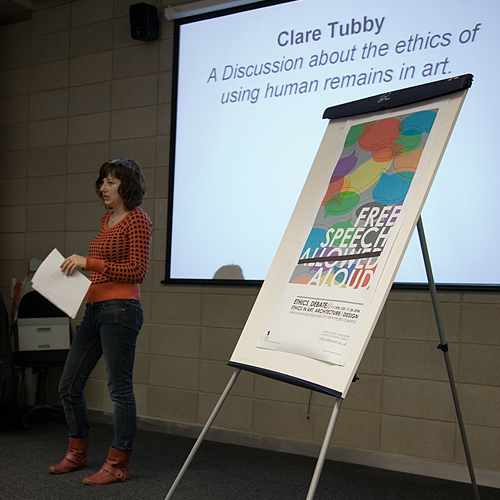By Krystin Dean, The Linc
Students had the opportunity to voice their opinions regarding modern ethical issues during Free Speech Aloud, an ethics debate for art, architecture and design students held in February.

According to the event’s facilitator, Lincoln School of Art and Design senior lecturer Mary O’Neill, the debate was a result of the increasing desire for both students and practitioners to carry out a process of ethical review of their work as part of a proposal or application. “Traditionally, architects, artists and designers have done this as an integral element of their practice; however, this series of ethical conversations allow the students to foreground some of this thought process,” explained O’Neill.
The event encompassed a two-part format in which three third-year fine art students discussed ethical implications of research conducted in their studies followed by ethical debates carried out by attendees. “We didn’t want the process to be adversarial so in fact it was more of a conversation; the word debate refers to the larger debate that is taking place about ethics,” said O’Neill. Rebecca Glover spoke about the ethical considerations of the work of Brazilian artist Lygia Clark, who was widely known for making her audience interact with the art work she created.
Clare Tubby (pictured above) then discussed the ethics of using human remains in art, which came about as a result of the student artist using unconventional materials in her work, such as knitting with masking tape. Tubby chose to examine Body Worlds 4, an exhibition created by German anatomist Gunther von Hagens featuring human bodies preserved using a process called plastination, at the Museum of Science and Industry in Manchester. “When looking at the ethics surrounding human bodies, I thought about whether the living have a duty to the dead in issues such as respecting their disposal and having their wishes carried out,” said Tubby. “When we talk about dead bodies, we always talk about how best to dispose of them rather than how best to use them, which implies that dead bodies are just waste and not useful.”
Media coverage surrounding von Hagens’s unusual attempt to find a practical use for dead bodies has often caused outrage and disgust amongst the general public, simultaneously resulting in a surge of over 26 million visitors to the various exhibitions worldwide. “This made me think about the framing about my own artwork, as far as the statements that are made and how to curate the work. These things should enhance the work, not be the only things holding the work together,” said Tubby. Dawn Taylor discussed the ethics of using images of children in contemporary art, a topic that was specifically interesting to her as she is a mother of two who frequently uses her children’s bodies in her artwork. “Some people would say that it isn’t right to use your children in your work. As a mother, I consider it absolutely fine because they’re my children and I know they’re not being hurt by it,” said Taylor.
However, Taylor also understands that when work featuring children is put on display, it presents ethical connotations for those viewing it. To learnmore, Taylor studied American photographer Jock Sturges, who is known for his images of nude adolescents which led an FBI raid to his art studio in 1990. “The research taught me that it’s important to know why I’m doing the work I’m doing and to have a good background. People need to know the story behind the work to judge it, and you can’t predict what an audience will say. As an artist, it’s our job to create a dialogue,” said Taylor.
This was precisely what happened next in the debate as small groups were challenged to tackle ethical situations surrounding art, design and architecture whilst considering certain criteria such as moral responsibility and ethical value. “Each group received a pack with information about either a building or artwork or painting that has, at one time or another, been described as unethical or that people have objected to being shown,” explained O’Neill.
The students were encouraged to analyse issues such as the much-discussed China Central Television headquarters created in Beijing by architect Rem Koolhaas as well as artist Guillermo Vargas Jiménez’s controversial gallery exhibition of an emaciated dog. “We make decisions constantly but we are often unaware of why we make them so this debate gives us an opportunity to actually think about the decisions we make automatically,” said O’Neill.
